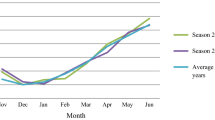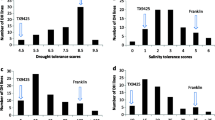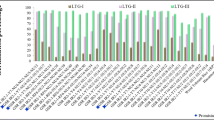Abstract
Thorough understanding of the genetic mechanisms governing drought adaptive traits can facilitate drought resistance improvement. This study was conducted to identify chromosome regions harbouring QTLs contributing for water stress resistance in wheat. A RIL mapping population derived from a cross between W7984 (Synthetic) and Opata 85 was phenotyped for root length and root dry weight under water stress and non-stress growing conditions. ANOVA showed highly significant (p ≤ 0.01) variation among the RILs for both traits. Root length and root dry weight showed positive and significant (p ≤ 0.01) phenotypic correlation. Broad sense heritability was 86% for root length under stress and 65% for root dry weight under non-stress conditions. A total of eight root length and five root dry weight QTLs were identified under both water conditions. Root length QTLs Qrln.uwa.1BL, Qrln.uwa.2DS, Qrln.uwa.5AL and Qrln.uwa.6AL combined explained 43% of phenotypic variation under non-stress condition. Opata was the source of favourable alleles for root length QTLs under non-stress condition except for Qrln.uwa.6AL. Four stress specific root length QTLs, Qrls.uwa.1AS, Qrls.uwa.3AL, Qrls.uwa.7BL.1 and Qrls.uwa.7BL.2 jointly explained 47% of phenotypic variation. Synthetic wheat contributed favourable alleles for Qrls.uwa.1AS and Qrls.uwa.3AL. Two stable root dry weight QTLs on chromosomes 4AL and 5AL were consistently found in both water conditions. Three validation populations were developed by crossing cultivars Lang, Yitpi, and Chara with Synthetic W7984 to transfer two of the QTLs identified under stress condition. The F2.3 and F3.4 validation lines were phenotyped under the same level of water stress as RILs to examine the effect of these QTLs. There were 13.5 and 14.5% increases in average root length due to the inheritance of Qrls.uwa.1AS and Qrls.uwa.3AL, respectively. The result indicated that closely linked SSR markers Xbarc148 (Qrls.uwa.1AS) and Xgwm391 (Qrls.uwa.3AL) can be incorporated into MAS for water stress improvement in wheat.


Similar content being viewed by others
References
Ayalew H, Wondale L, Teshager A (2014) Gge biplot analysis on the performance of wheat genotype for hectolitre weight and mega environments identification in north western Ethiopia. Aust J Crop Sci 8:1435
Ayalew H, Ma X, Yan G (2015) Screening wheat (Triticum spp.) genotypes for root length under contrasting water regimes: potential sources of variability for drought resistance breeding. J Agron Crop Sci 201:189–194. doi:10.1111/jac.12116
Ayalew H, Dessalegn T, Liu H, Yan G (2016a) Performance of ethiopian bread wheat (Tritium aestivum L.) genotypes under contrasting water regimes: potential sources of variability for drought resistance breeding. Aus J Crop Sci 10:370–376
Ayalew H, Liu H, Yan GJ (2016b) Quantitative analysis of gene actions controlling root length under water stress in spring wheat (Triticum aestivum L.) genotypes. Crop Pasture Sci 67:489–494. doi:10.1071/Cp15244
Bai CH, Liang YL, Hawkesford MJ (2013) Identification of QTLs associated with seedling root traits and their correlation with plant height in wheat. J Exp Bot 64:1745–1753. doi:10.1093/jxb/ert041
Barakat MN, Saleh MS, Al-Doss AA, Moustafa KA, Elshafei AA, Zakri AM, Al-Qurainy FH (2015) Mapping of QTLs associated with abscisic acid and water stress in wheat. Biol Plant 59:291–297. doi:10.1007/s10535-015-0499-9
Blum A (2011a) Drought resistance—is it really a complex trait? Func Plant Biol 38:753–757
Blum A (2011b) Plant breeding for water-limited environments. Springer, New York
Blum A (2014) Genomics for drought resistance—getting down to earth. Func Plant Biol 41:1191–1198. doi:10.1071/Fp14018
Blum A, Sinmena B, Ziv O (1980) An evaluation of seed and seedling drought tolerance screening-tests in wheat. Euphytica 29:727–736. doi:10.1007/Bf00023219
Borner A, Schumann E, Furste A, Coster H, Leithold B, Roder S, Weber E (2002) Mapping of quantitative trait loci determining agronomic important characters in hexaploid wheat (Triticum aestivum L.). Theor Appl Genet 105:921–936. doi:10.1007/s00122-002-0994-1
Breseghello F, Sorrells ME (2007) QTL analysis of kernel size and shape in two hexaploid wheat mapping populations. Field Crop Res 101:172–179
Budak H, Hussain B, Khan Z, Ozturk NZ, Ullah N (2015) From genetics to functional genomics: improvement in drought signaling and tolerance in wheat. Front Plant Sci 6:1012. doi:10.3389/fpls.2015.01012
Cane MA, Maccaferri M, Nazemi G, Salvi S, Francia R, Colalongo C, Tuberosa R (2014) Association mapping for root architectural traits in durum wheat seedlings as related to agronomic performance. Mol Breed 34:1629–1645. doi:10.1007/s11032-014-0177-1
Collard BC, Mackill DJ (2008) Marker-assisted selection: an approach for precision plant breeding in the twenty-first century. Philos Trans R Soc Lond B 363:557–572. doi:10.1098/rstb.2007.2170
Collard BCY, Jolley R, Bovill WD, Grams RA, Wildermuth GB, Sutherland MW (2006) Confirmation of QTL mapping and marker validation for partial seedling resistance to crown rot in wheat line ‘2-49’. Aust J Agric Res 57:967–973. doi:10.1071/Ar05419
Comas LH, Becker SR, Cruz VM, Byrne PF, Dierig DA (2013) Root traits contributing to plant productivity under drought. Front Plant Sci 4:442. doi:10.3389/fpls.2013.00442
Edae EA, Byrne PF, Manmathan H, Haley SD, Moragues M, Lopes MS, Reynolds MP (2013) Association mapping and nucleotide sequence variation in five drought tolerance candidate genes in spring wheat. Plant Genome. doi:10.3835/plantgenome2013.04.0010
Falconer DS, Mackay TFC (1996) Introduction to quantitative genetics, 4th edn. Longman, Burnt Mill
Fleury D, Jefferies S, Kuchel H, Langridge P (2010) Genetic and genomic tools to improve drought tolerance in wheat. J Exp Bot 61:3211–3222. doi:10.1093/jxb/erq152
Hoffmann A, Maurer A, Pillen K (2012) Detection of nitrogen deficiency QTL in juvenile wild barley introgression lines growing in a hydroponic system. BMC Genet 13:88. doi:10.1186/1471-2156-13-88
Kamoshita A, Wade J, Ali L, Pathan S, Zhang J, Sarkarung S, Nguyen T (2002) Mapping QTLs for root morphology of a rice population adapted to rainfed lowland conditions. Theor Appl Genet 104:880–893. doi:10.1007/s00122-001-0837-5
Kipp S, Mistele B, Baresel P, Schmidhalter U (2014) High-throughput phenotyping early plant vigour of winter wheat. Eur J Agron 52(Part B):271–278. doi:10.1016/j.eja.2013.08.009
Landjeva S, Korzun V, Stoimenova E, Truberg B, Ganeva G, Börner A (2008) The contribution of the gibberellin-insensitive semi-dwarfing (rht) genes to genetic variation in wheat seedling growth in response to osmotic stress. J Agric Sci 146:275–286
Li Z, Mu P, Li C, Zhang H, Li Z, Gao Y, Wang X (2005) QTL mapping of root traits in a doubled haploid population from a cross between upland and lowland japonica rice in three environments. Theor Appl Genet 110:1244–1252
Maccaferri M, El-Feki W, Nazemi G, Salvi S, Canè MA, Colalongo MC, Stefanelli S, Tuberosa R (2016) Prioritizing quantitative trait loci for root system architecture in tetraploid wheat. J Exp Bot 67:1161–1178
Manschadi AM, Christopher J, Devoil P, Hammer GL (2006) The role of root architectural traits in adaptation of wheat to water-limited environments. Funct Plant Biol 33:823–837. doi:10.1071/Fp06055
Meister R, Rajani M, Ruzicka D, Schachtman DP (2014) Challenges of modifying root traits in crops for agriculture. Trend Plant Sci 19:779–788
Nyquist WE (1991) Estimation of heritability and prediction of selection response in plant-populations. Crit Rev Plant Sci 10:235–322. doi:10.1080/07352689109382313
Ortiz R, Sayre K, Govaerts B, Gupta R, Subbarao G, Ban T, Hodson D, Dixon J, Ortiz-Monasterio I (2008) Climate change: can wheat beat the agriculture? Agric Ecosyst Environ 126:46–58
Palomeque L, Liu L-J, Li W, Hedges BR, Cober ER, Smid MP, Lukens L, Rajcan I (2010) Validation of mega-environment universal and specific QTL associated with seed yield and agronomic traits in soybeans. Theor Appl Genet 120:997–1003
Palta JA, Chen X, Milroy SP, Rebetzke GJ, Dreccer MF, Watt M (2011) Large root systems: are they useful in adapting wheat to dry environments? Funct Plant Biol 38:347. doi:10.1071/fp11031
Parent B, Shahinnia F, Maphosa L, Berger B, Rabie H, Chalmers K, Kovalchuk A, Langridge P, Fleury D (2015) Combining field performance with controlled environment plant imaging to identify the genetic control of growth and transpiration underlying yield response to water-deficit stress in wheat. J Exp Bot 66:5481–5492
Passioura JB (2012) Phenotyping for drought tolerance in grain crops: when is it useful to breeders? Funct Plant Biol 39:851–859
Peng JHH, Sun DF, Nevo E (2011) Domestication evolution, genetics and genomics in wheat. Mol Breed 28:281–301. doi:10.1007/s11032-011-9608-4
Qu Y, Mu P, Zhang H, Chen CY, Gao Y, Tian Y, Wen F, Li Z (2008) Mapping QTLs of root morphological traits at different growth stages in rice. Genetica 133:187–200. doi:10.1007/s10709-007-9199-5
Rebetzke GJ, Condon AG, Farquhar GD, Appels R, Richards RA (2008) Quantitative trait loci for carbon isotope discrimination are repeatable across environments and wheat mapping populations. Theor Appl Genet 118:123–137. doi:10.1007/s00122-008-0882-4
Reynolds M, Dreccer F, Trethowan R (2007) Drought-adaptive traits derived from wheat wild relatives and landraces. J Exp Bot 58:177–186
Schlenker W, Lobell DB (2010) Robust negative impacts of climate change on african agriculture. Environ Res Lett 5:014010. doi:10.1088/1748-9326/5/1/014010
Semagn K, Bjornstad A, Ndjiondjop MN (2006) An overview of molecular marker methods for plants. Afr J Biotechnol 5:2540–2568
Semagn K, Bjørnstad Å, Xu Y (2010) The genetic dissection of quantitative traits in crops. Electron J Biotechnol 13:16–17
Sharma S, Xu S, Ehdaie B, Hoops A, Close TJ, Lukaszewski AJ, Waines JG (2011) Dissection of QTL effects for root traits using a chromosome arm-specific mapping population in bread wheat. Theor Appl Genet 122:759–769
Sohail Q, Inoue T, Tanaka H, Eltayeb AE, Matsuoka Y, Tsujimoto H (2011) Applicability of aegilops tauschii drought tolerance traits to breeding of hexaploid wheat. Breed Sci 61:347–357. doi:10.1270/jsbbs.61.347
Song QJ, Shi JR, Singh S, Fickus EW, Costa JM, Lewis J, Gill BS, Ward R, Cregan PB (2005) Development and mapping of microsatellite (SSR) markers in wheat. Theor Appl Genet 110:550–560. doi:10.1007/s00122-004-1871-x
Song J, Braun G, Bevis E, Doncaster K (2006) A simple protocol for protein extraction of recalcitrant fruit tissues suitable for 2-de and ms analysis. Electrophoresis 27:3144–3151. doi:10.1002/elps.200500921
Specht JE, Chase K, Macrander M, Graef GL, Chung J, Markwell JP, Germann M, Orf JH, Lark KG (2001) Soybean response to water. Crop Sci 41:493–509. doi:10.2135/cropsci2001.412493x
Swain S, Wardlow BD, Narumalani S, Rundquist DC, Hayes MJ (2013) Relationships between vegetation indices and root zone soil moisture under maize and soybean canopies in the us corn belt: a comparative study using a close-range sensing approach. Int J Remote Sens 34:2814–2828
Tardieu F (2012) Any trait or trait-related allele can confer drought tolerance: just design the right drought scenario. J Exp Bot 63:25–31. doi:10.1093/jxb/err269
Tuberosa R (2012) Phenotyping for drought tolerance of crops in the genomics era. Front Physiol 3:347. doi:10.3389/fphys.2012.00347
Uga Y, Sugimoto K, Ogawa S, Rane J, Ishitani M, Hara N, Kitomi Y, Inukai Y, Ono K, Kanno N (2013) Control of root system architecture by deeper rooting 1 increases rice yield under drought conditions. Nat Genet 45:1097–1102
Vaughn LM, Nguyen HT (2013) The effect of moisture extremes on plant roots and their connections with otherabiotic tresses. In: Crespi M (ed) Root genomics and soil interactions. Wiley, Hoboken
Voorrips RE (2002) Mapchart: software for the graphical presentation of linkage maps and QTLs. J Hered 93:77–78
VSN International (2014) Genstat 17th edition for windows. VSN International, Hemel Hempstead
Wang S, Basten CJ, Zeng ZB (2012) Windows QTL cartographer, 2.5th edn. Department of Statistics, North Carolina State University, Raleigh
Wasson AP, Richards RA, Chatrath R, Misra SC, Prasad SV, Rebetzke GJ, Kirkegaard JA, Christopher J, Watt M (2012) Traits and selection strategies to improve root systems and water uptake in water-limited wheat crops. J Exp Bot 63:3485–3498. doi:10.1093/jxb/ers111
Wei B, Jing R, Wang C, Chen J, Mao X, Chang X, Jia J (2009) Dreb1 genes in wheat (Triticum aestivum L.): development of functional markers and gene mapping based on snps. Mol Breed 23:13–22. doi:10.1007/s11032-008-9209-z
Williams K, Sorrells ME (2014) Three-dimensional seed size and shape QTL in hexaploid wheat (l.) populations. Crop Sci 54:98–110
Wilson PB, Rebetzke GJ, Condon AG (2015) Pyramiding greater early vigour and integrated transpiration efficiency in bread wheat; trade-offs and benefits. Field Crop Res 183:102–110. doi:10.1016/j.fcr.2015.07.002
Yan WK, Holland JB (2010) A heritability-adjusted gge biplot for test environment evaluation. Euphytica 171:355–369. doi:10.1007/s10681-009-0030-5
Zhang L, Richards R, Condon A, Liu D, Rebetzke G (2014) Recurrent selection for wider seedling leaves increases early biomass and leaf area in wheat (Triticum aestivum L.). J Exp Bot 66(5):1215–1226
Zheng BS, Yang L, Mao CZ, Huang YJ, Wu P (2008) Mapping QTLs for morphological traits under two water supply conditions at the young seedling stage in rice. Plant Sci 175:767–776. doi:10.1016/j.plantsci.2008.07.012
Zhou WC, Kolb F, Bai GH, Domier L, Boze L, Smith N (2003) Validation of a major QTL for scab resistance with SSR markers and use of marker-assisted selection in wheat. Plant Breed 122:40–46
Acknowledgements
Australian development scholarship funded the study of the first author. We thank Dr Chunji Liu of CSIRO for providing some of the wheat genotypes.
Author information
Authors and Affiliations
Corresponding authors
Rights and permissions
About this article
Cite this article
Ayalew, H., Liu, H. & Yan, G. Identification and validation of root length QTLs for water stress resistance in hexaploid wheat (Titicum aestivum L.). Euphytica 213, 126 (2017). https://doi.org/10.1007/s10681-017-1914-4
Received:
Accepted:
Published:
DOI: https://doi.org/10.1007/s10681-017-1914-4




